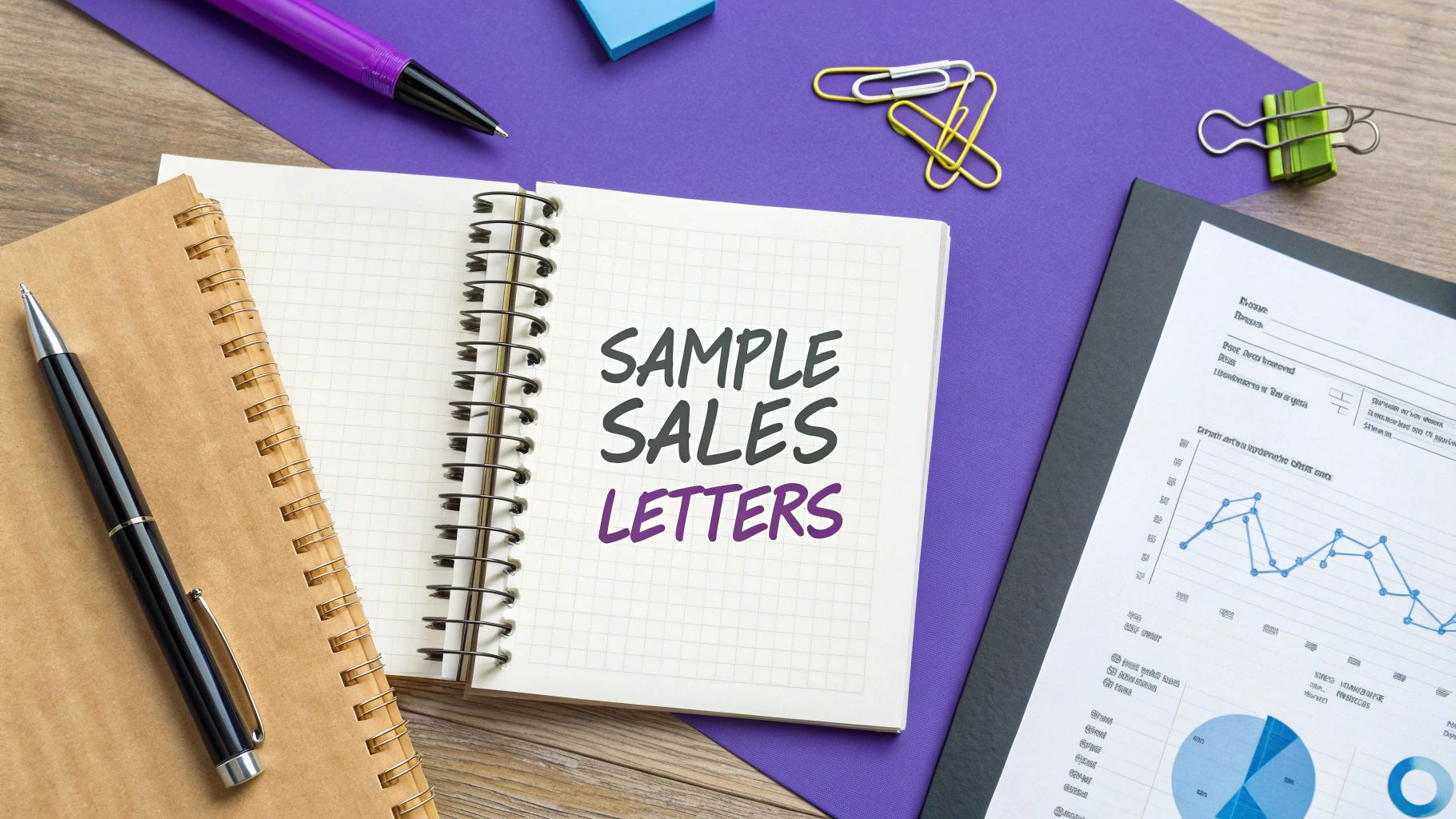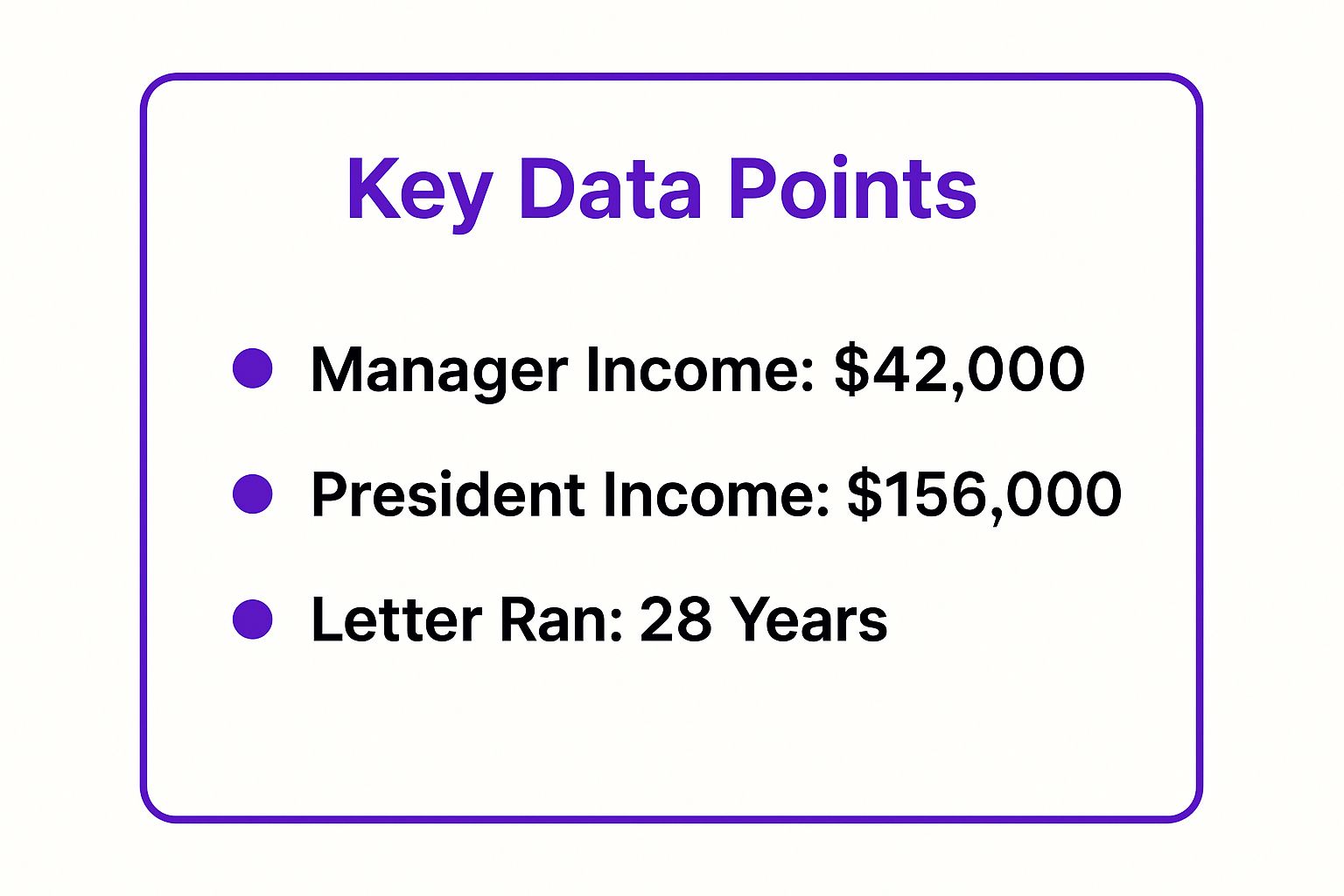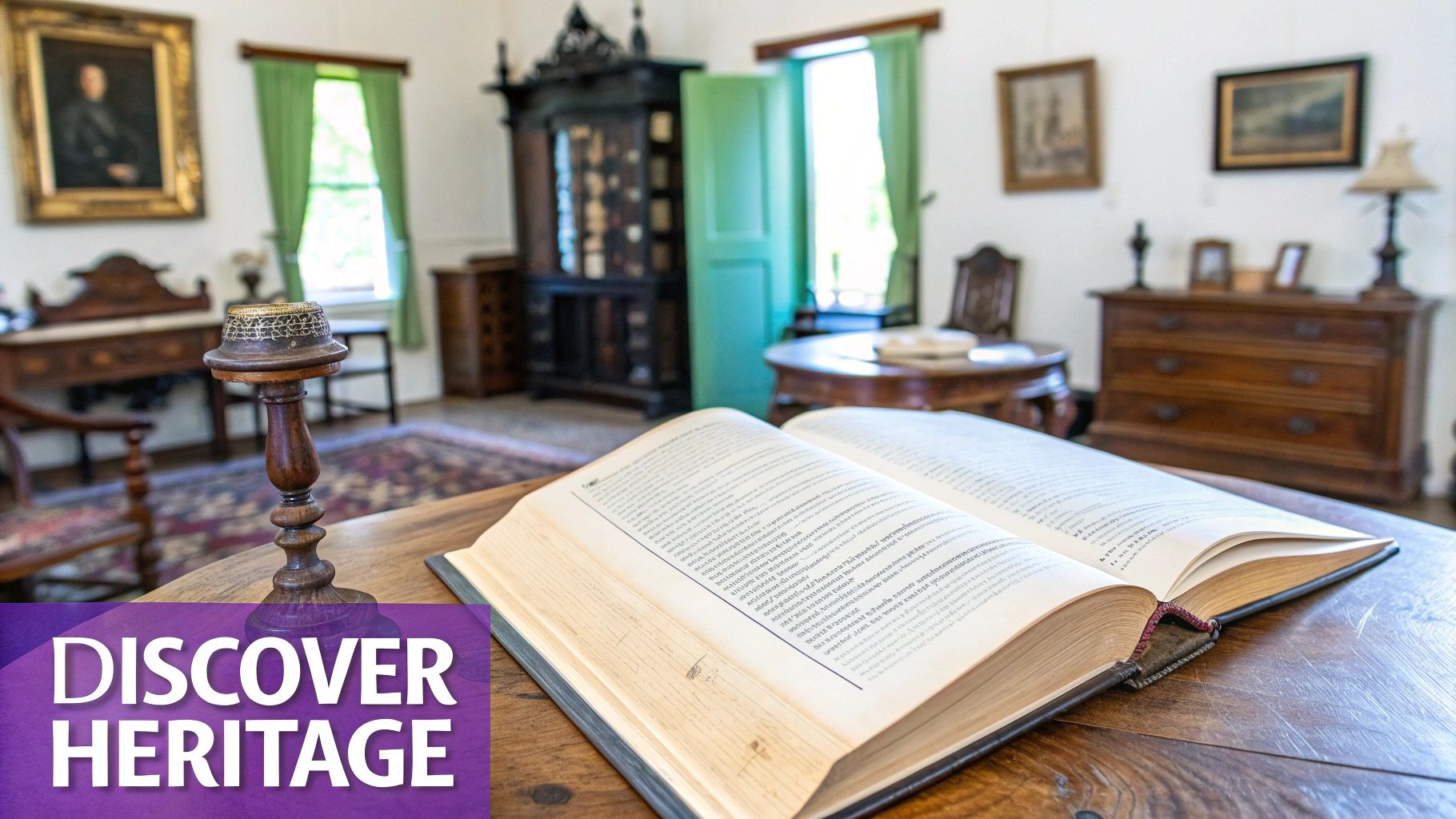
Effective Sample Sales Letters You Can Use Today
Discover proven sample sales letters that boost conversions. Learn tactics to craft persuasive messages and grow your sales now.
Cody Y.
Updated on Sep 15, 2025
In the age of AI and automation, does a well-crafted letter still have the power to persuade? Absolutely. A great sales letter is more than just words on a page; it’s a masterclass in human psychology, a direct line to a prospect's core desires and most pressing pain points. While the delivery method may have shifted from direct mail to email inboxes, the fundamental principles of crafting a compelling argument remain timeless and more relevant than ever.
This article dives deep into eight legendary sample sales letters that have collectively generated billions in revenue and fundamentally shaped modern marketing. We won't just show you these iconic pieces of copy. We will meticulously dissect the strategic genius behind them, revealing the specific tactics, powerful psychological triggers, and replicable frameworks you can immediately adapt for your own campaigns.
Get ready to go beyond surface-level examples. We'll break down the precise mechanics of what makes these letters work, from their attention-grabbing headlines to their irresistible calls to action. You will learn not just what they wrote, but why they wrote it that way. The goal is to provide you with a strategic toolkit of proven techniques to supercharge your sales and marketing efforts today.
1. The Wall Street Journal 'Two Young Men' Sales Letter
Kicking off our list of sample sales letters is arguably the most successful direct mail piece in history. Written by Martin Conroy, the "Two Young Men" letter for The Wall Street Journal ran for an incredible 28 years, reportedly generating over $2 billion in subscriptions. Its brilliance lies in its simplicity and powerful use of narrative to illustrate the value of information.
The letter tells a compelling story of two men with identical backgrounds who start their careers at the same company. Twenty-five years later, one is a mid-level manager, while the other is the company president. The difference? The successful man was a reader of The Wall Street Journal. This narrative-driven approach transforms an abstract benefit (being well-informed) into a tangible, aspirational outcome: career success and wealth.
Strategic Breakdown
- Relatable Narrative: The story is simple and universally understood. Everyone knows someone who seemed to have the same opportunities but achieved vastly different results. This taps into the reader’s curiosity and desire for a competitive edge.
- Aspirational Contrast: The letter masterfully contrasts the two outcomes, making the desired path crystal clear. It positions the product not just as a newspaper, but as the key differentiator between mediocrity and success.
- Emotional Hook: It leverages feelings of ambition, envy, and the fear of being left behind. The core message is that a small investment in knowledge can yield enormous returns over a lifetime.
The infographic below highlights the key figures that made this letter's narrative so impactful.

These figures create a stark, memorable contrast that immediately quantifies the value proposition of reading the Journal.
How to Adapt This Strategy
This sample sales letter provides a powerful template for any business selling a product or service with long-term, less tangible benefits like education, software, or consulting.
- Create a "Sliding Doors" Scenario: Craft a story comparing two similar individuals or businesses. One uses your solution, and the other does not. Detail their divergent paths over time.
- Focus on the Outcome: Don't just list features. Show, through storytelling, the tangible success your customer will achieve.
- Keep it Simple: The power of the WSJ letter is its clarity. Avoid complex jargon and focus on a single, powerful message that drives your point home.
2. Gary Halbert's 'Coat of Arms' Letter
Next on our list is a masterpiece of direct response copywriting by the legendary Gary Halbert. The "Coat of Arms" letter, also known as the "Tontine" letter, was a direct mail campaign that sold family crest reports to people with the same last name. It brilliantly tapped into the universal human desires for identity, legacy, and a connection to the past, reportedly generating over $20 million and launching an entire industry.
The letter's genius was its intensely personal and curiosity-driven approach. It started by addressing the recipient by their surname, informing them that a special historical report about their family name had been completed. This immediately made the mass-produced letter feel like a one-to-one communication, creating an irresistible hook that compelled people to read on and discover more about their heritage.

Strategic Breakdown
- Personalization at Scale: By simply matching a mailing list of last names to the letter's opening, Halbert created the illusion of a deeply personal message. This is a core lesson in making the reader feel seen and understood.
- Curiosity and Intrigue: The letter didn't sell a product; it offered a revelation about the reader's own identity. It hinted at a fascinating story about their family name, creating an information gap the reader felt compelled to fill.
- Implied Scarcity: The letter often mentioned the report was recently completed and implied a limited availability, urging a quick response before the opportunity was lost. This created urgency without resorting to aggressive sales tactics.
This approach transformed a generic product into a unique and personal discovery, making it one of the most effective sample sales letters in history.
How to Adapt This Strategy
Halbert's strategy is perfect for businesses that can connect their products to a customer's identity, history, or personal interests.
- Lead with an "Identity Hook": Start your sales letter by referencing something unique to the reader. This could be their location, profession, a recently purchased product, or even their name.
- Sell the Discovery, Not the Product: Frame your offer as an opportunity for the customer to learn something new about themselves or their situation. Spark their curiosity first, then introduce your solution as the key to satisfying it.
- Make It Feel Exclusive: Use language that suggests the information or offer is newly available or tailored specifically for them. This creates a sense of importance and encourages immediate action.
3. John Caples' 'They Laughed When I Sat Down' Piano Ad
Next on our list of iconic sample sales letters is a masterpiece of storytelling and emotional payoff. Created by legendary copywriter John Caples in 1926 for the U.S. School of Music, this ad’s headline became one of the most famous and imitated in history. It ran for decades, pulling in new students who dreamed of a similar transformation.
The ad tells the story of a man, Jack, who is the butt of his friends' jokes when he sits down at a piano during a party. The laughter turns to stunned silence and then thunderous applause as he plays a beautiful piece. This dramatic reversal of social standing powerfully demonstrates the value of the correspondence music course, turning a private skill into a public triumph.

Strategic Breakdown
- Intriguing Headline: The headline "They Laughed When I Sat Down At The Piano But When I Started to Play!~" creates immediate curiosity and tension. The reader is compelled to find out what happened next.
- Social Proof as the Goal: The ad doesn't sell piano lessons; it sells admiration, respect, and the sweet victory of proving doubters wrong. The benefit is entirely social and emotional, which is a far more powerful motivator than simply learning a skill.
- Relatable Underdog Story: The narrative taps into the universal desire to overcome embarrassment and shine in front of peers. Everyone has felt underestimated, making Jack’s triumph feel personal and attainable.
How to Adapt This Strategy
This sample sales letter provides an evergreen formula for any product or service that helps people acquire a new skill, improve their confidence, or achieve a visible transformation.
- Craft a "Before and After" Narrative: Tell a story that contrasts a moment of doubt or embarrassment (the "before") with a moment of triumph and admiration (the "after"). This works for fitness programs, public speaking courses, software training, and more.
- Show, Don't Just Tell, the Transformation: Use vivid details to paint a picture of the scene. Caples described the whispers, the giggles, and finally, the "roar of applause." This makes the emotional payoff feel real.
- Promise a Social Reward: Frame the benefit of your product not just in terms of the skill itself, but in how it will change the way others see and interact with your customer.
4. Eugene Schwartz's 'Lazy Man's Way to Riches' Letter
Next on our list of influential sample sales letters is a masterpiece of direct response copywriting by the legendary Eugene Schwartz. This letter, written to sell Joe Karbo's book, "The Lazy Man's Way to Riches," is a masterclass in addressing reader skepticism head-on while presenting an almost unbelievable offer. It brilliantly tapped into the universal desire for wealth without the grind.
The letter's genius lies in its disarming, conversational tone. Schwartz starts by acknowledging the outrageousness of the claim, immediately aligning with the reader's own doubts. He then systematically dismantles every potential objection with proof, logic, and a powerful guarantee. This approach transforms a get-rich-quick scheme into a credible, low-risk opportunity for the average person, making the book a massive commercial success and a model for the information marketing industry.
Strategic Breakdown
- Preemptive Objection Handling: The letter anticipates and vocalizes the reader’s skepticism. By saying, "I know you're skeptical," Schwartz builds trust and demonstrates that he understands the reader's mindset.
- Irresistible "Big Idea": The core concept of achieving wealth with minimal effort is a powerful hook. It frames the product not as hard work, but as a clever shortcut that anyone can use.
- Overwhelming Proof & Credibility: Schwartz doesn't just make claims; he backs them up with specific details, testimonials, and a bulletproof, money-back guarantee that completely reverses the risk for the buyer.
How to Adapt This Strategy
This sample sales letter is perfect for businesses selling information products, courses, or any solution that might seem "too good to be true."
- Acknowledge Skepticism Directly: Start your copy by addressing the biggest doubt in your prospect's mind. Use phrases like, "I know what you're probably thinking..." to build instant rapport.
- Layer Your Proof: Don't rely on one type of evidence. Combine testimonials, data points, case studies, and a strong guarantee to create an unshakeable case for your product's value.
- Frame Your Solution as an "Easy Button": Identify the most difficult or frustrating part of the problem your audience faces and position your product as the simple, elegant, or even "lazy" way to solve it.
5. David Ogilvy's Rolls-Royce 'At 60 Miles an Hour' Letter
Next on our list of influential sample sales letters is an iconic advertisement that reads like a detailed, fact-driven letter. Crafted by advertising legend David Ogilvy, the Rolls-Royce ad with the headline, "At 60 miles an hour the loudest noise in this new Rolls-Royce comes from the electric clock," is a masterclass in turning product features into compelling benefits. It rejects vague, boastful claims in favor of specific, verifiable facts that build undeniable credibility and desire.
The ad’s power comes from its specificity. Instead of just saying the car is "quiet" or "luxurious," Ogilvy leads with an astonishing, memorable fact that illustrates the point perfectly. The body copy then continues this approach, listing 13 meticulously researched details that prove the car's superior engineering and craftsmanship. This method respects the reader's intelligence while painting an irresistible picture of quality.

Strategic Breakdown
- Lead with the Best Fact: The headline immediately grabs attention by presenting the product’s most compelling proof point. It's intriguing, confident, and makes the reader want to learn more.
- Transform Features into Benefits: The letter doesn't just list technical specs; it implies the emotional payoff. The quiet clock signifies tranquility, precision, and an escape from the noisy world, which are the true desires of a luxury buyer.
- Build Trust with Detail: The exhaustive list of facts and features acts as overwhelming proof of quality. It suggests that if the company pays this much attention to the small details, the major components must be flawless.
How to Adapt This Strategy
This fact-based approach is perfect for businesses selling premium, technical, or complex products where quality and performance are key differentiators.
- Find Your "Electric Clock": Dive deep into your product research. Identify the single most impressive, surprising, or counterintuitive fact about your offering and build your headline around it.
- Show, Don't Just Tell: Instead of using generic adjectives like "high-quality" or "innovative," list the specific details, processes, or materials that make it so. Let the facts speak for themselves.
- Arm Your Reader with Proof: Provide your audience with concrete data and details they can use to justify their purchasing decision, both to themselves and to others. This builds confidence and shortens the sales cycle.
6. Claude Hopkins' 'Pepsodent Toothpaste' Campaign Letters
Next in our list of pivotal sample sales letters is a campaign that didn't just sell a product; it created a national habit. Legendary ad man Claude Hopkins, working for Lord & Thomas, was tasked with selling Pepsodent toothpaste at a time when very few Americans brushed their teeth daily. His genius was in identifying an invisible problem and making it tangible.
Hopkins’ letters and ads focused on the “dingy film” on teeth that everyone could feel with their tongue. He didn't invent the film, but he named it and framed it as an unattractive problem. The campaign then presented Pepsodent as the solution, offering a noticeable reward: a cleaner, brighter feeling after brushing. This simple “cue-routine-reward” loop, as described later in Charles Duhigg's The Power of Habit, successfully transformed Pepsodent from a minor player to a dominant brand and established daily toothbrushing as a norm.
Strategic Breakdown
- Make the Invisible Visible: Hopkins took a universal but overlooked sensation (the film on teeth) and turned it into a clear, identifiable problem that needed a solution. This created an immediate need in the prospect’s mind.
- Create a Habit Loop (Cue-Routine-Reward): The strategy was built on a simple psychological trigger. The cue was feeling the film, the routine was brushing with Pepsodent, and the reward was the clean, slippery feeling of the teeth afterward. This created a craving for the reward.
- Promise a Simple, Immediate Payoff: The letters didn't focus on long-term dental health. Instead, they promised an immediate, tangible benefit: a more beautiful smile and a wonderfully clean feeling right now.
This approach shifted the focus from a vague health benefit to an immediate, satisfying experience that consumers wanted to repeat.
How to Adapt This Strategy
This habit-forming framework is incredibly effective for products that require regular use, such as software, supplements, or subscription services.
- Identify a Tangible "Cue": Find a common, everyday problem or sensation that your product can solve. Frame it as an annoyance that your customer can now eliminate.
- Provide a Clear "Reward": Ensure your product delivers an immediate, noticeable benefit. This could be a feeling of accomplishment, a visible result, or a satisfying user experience.
- Keep the "Routine" Simple: The action you want the customer to take should be easy and straightforward. The simpler the routine, the more likely the habit will stick.
7. Robert Collier's 'Letter Book' Sales Letters
Next on our list of influential sample sales letters are the foundational works of Robert Collier. His principles, compiled in The Robert Collier Letter Book, are less a single template and more a masterclass in direct response psychology. Collier’s genius was in his ability to enter the conversation already happening in the customer's mind, a principle that remains a cornerstone of effective marketing today.
Instead of leading with a product, Collier’s letters started with the reader’s core desires, problems, or emotions. He famously stated that the successful letter writer must first find a 'hook' that resonates with the prospect's immediate interests. By painting a vivid picture of the reader's desired outcome and building emotional investment, he made the product seem like the natural and only solution. This approach generated millions in sales across diverse industries, from books to raincoats.
Strategic Breakdown
- Enter the Existing Conversation: Collier's primary rule was to connect with a reader's existing thoughts and feelings. The sales message doesn't interrupt; it joins a conversation already in progress.
- Desire First, Solution Second: He masterfully built a powerful sense of desire or amplified a pain point before ever mentioning what he was selling. This creates a psychological vacuum that only the product can fill.
- Emotional Storytelling: He used narratives not just for engagement but to make abstract benefits feel tangible and immediate. A story about achieving wealth is far more compelling than a list of investment features.
How to Adapt This Strategy
Collier’s psychological approach is timeless and highly adaptable for modern digital marketing, especially for products or services that solve complex emotional problems.
- Lead with Empathy: Start your sales copy by describing a problem or desire your audience feels deeply. Use headlines and opening lines that reflect their internal monologue.
- Agitate the Problem: Before presenting your solution, spend time exploring the consequences of inaction. Show them the "what if" scenario if the problem goes unsolved.
- Frame Your Product as the Inevitable Next Step: Once you've established the emotional context and need, introduce your product as the logical, essential bridge from their current pain to their desired future.
8. Dan Kennedy's 'No B.S.' Newsletter Promotion Letters
Dan Kennedy, a titan of direct response marketing, built an empire by defying conventional wisdom. His sales letters for the "No B.S." newsletter series are legendary for their abrasive, contrarian, and unapologetically direct style. Instead of trying to please everyone, Kennedy's letters deliberately target a specific type of reader: the frustrated, skeptical business owner tired of mainstream marketing fluff.
These letters work by establishing Kennedy as an unfiltered, authoritative voice in a sea of mediocrity. He uses bold, controversial statements to grab attention and promises to deliver the hard truths and actionable strategies that others are too afraid to share. This approach built a fiercely loyal following and a multi-million dollar information marketing business, proving that personality and a strong point of view can be your most powerful sales tools.
Strategic Breakdown
- Contrarian Positioning: The letters immediately set up an "us vs. them" dynamic. Kennedy positions himself and his readers against the "gurus," "frauds," and ineffective traditional marketers, creating an instant bond with those who share his frustrations.
- Personality as the Brand: The tone is pure Kennedy: blunt, opinionated, and confident. The sales letter isn't just selling information; it's selling access to his unique, no-nonsense perspective. This makes the offer impossible to commoditize.
- Promise of "Secret" Knowledge: The core appeal is the promise of insider information that cuts through the noise. He pledges to reveal what really works in marketing, not just the rehashed theories taught in business schools.
How to Adapt This Strategy
This approach is highly effective for consultants, coaches, and experts who have a strong, unique viewpoint. It's one of the best sample sales letters to model if your brand is built on your personality.
- Take a Strong Stance: Identify a common frustration or a widely accepted "truth" in your industry and argue against it. Don't be afraid to be provocative to get your point across.
- Inject Your Personality: Write how you talk. Let your unique voice, opinions, and even your quirks shine through. This builds a genuine connection that resonates more deeply than polished corporate-speak.
- Create an Exclusive Club: Frame your product or service as a community for like-minded individuals who "get it." Promise to deliver the insights they can't find anywhere else, making them feel like part of an inner circle.
Comparison of 8 Classic Sales Letters
| Sales Letter / Campaign | 🔄 Implementation Complexity | 💡 Resource Requirements | 📊 Expected Outcomes | 🎯 Ideal Use Cases | ⭐ Key Advantages |
|---|---|---|---|---|---|
| The Wall Street Journal "Two Young Men" Sales Letter | Moderate – Storytelling with simple structure | Low – Direct mail production & copywriting | High – Proven longevity and millions in subscriptions | Publishing, B2B, Financial Services | Emotional connection, relatable story |
| Gary Halbert's "Coat of Arms" Letter | Moderate to High – Multiple CTAs and detailed benefits | Moderate – Personalized direct mail with legal checks | High – Millions in revenue, scalable | Genealogy, Personal heritage services | Strong curiosity appeal, trust building |
| John Caples' "They Laughed When I Sat Down" Piano Ad | Moderate – Dramatic narrative, emotionally charged | Moderate – Print ad production & storytelling skills | High – Long-running success and influence | Education, Skill-based courses | Memorable transformation story |
| Eugene Schwartz's "Lazy Man's Way to Riches" Letter | High – Objection handling, psychological triggers | Moderate – Skilled copywriting & mail execution | High – Millions generated, info product launches | Info products, Financial education | Effective skepticism management |
| David Ogilvy's Rolls-Royce "At 60 Miles an Hour" Letter | High – Fact-based, requires product precision | High – Research, luxury production & print ads | High – Premium brand positioning in luxury market | Automotive, Luxury goods | Credibility through specificity and quality |
| Claude Hopkins' "Pepsodent Toothpaste" Campaign | High – Habit-loop creation & mass education | High – Large-scale marketing and education efforts | Very High – Market transformation & dominance | Consumer health products | Created new market, habit formation |
| Robert Collier's "Letter Book" Sales Letters | High – Deep psychological insight & storytelling | High – Skilled copywriting & segmentation | High – Multi-industry effectiveness | Multiple industries | Timeless principles, emotional persuasion |
| Dan Kennedy's "No B.S." Newsletter Promotion Letters | Moderate – Contrarian content with strong voice | Low to Moderate – Copywriting & email/mail setup | High – Loyal audience and premium pricing | Business, Marketing education | Differentiation, strong brand personality |
From Classic Principles to Modern Application: Writing Your Own Winning Sales Letter
We've journeyed through the masterworks of copywriting legends, from Ogilvy’s quiet confidence to Halbert’s audacious personalization. The common thread weaving through these legendary sample sales letters isn't a magic formula but a deep, empathetic understanding of human nature. They prove that effective selling isn't about shouting the loudest; it's about connecting with a specific person's deepest desires, fears, and aspirations.
The examples, from the aspirational story of The Wall Street Journal's 'Two Young Men' to the direct, benefit-driven pitch in Eugene Schwartz's work, are more than historical artifacts. They are blueprints for persuasion that remain powerfully relevant in our digital age. Whether you're writing a product description, a landing page, or a multi-part email sequence, these core principles are your strategic foundation.
Distilling Timeless Wisdom into Actionable Tactics
The most critical takeaway is that structure and emotion are two sides of the same coin. The masters didn't just write; they engineered their letters with meticulous precision. They understood that a compelling narrative must be built upon a logical framework that guides the reader from curiosity to conviction.
Here are the essential, replicable strategies we've uncovered:
- The Irresistible Hook: Every single masterwork begins with a powerful opening that grabs the reader's attention by challenging a belief, telling a story, or making a bold promise. John Caples' "They Laughed When I Sat Down..." is the quintessential example of this principle in action.
- Empathy Over Ego: The best sales letters are relentlessly focused on the reader's world. They speak to the customer's problems, validate their frustrations, and present the product as the logical, satisfying solution. This is not about your company's history; it's about the customer's future.
- Credibility Through Specificity: Vague claims are forgotten. David Ogilvy’s Rolls-Royce ad became iconic because of its concrete details, like the ticking of the electric clock. Specificity builds trust and makes your promises believable.
- A Clear, Compelling Call to Action: Confusion is the enemy of conversion. The legends were masters of telling the prospect exactly what to do next, why they should do it now, and what they would gain from it.
Modernizing the Masters' Methods
Translating these classic strategies into today’s fast-paced digital environment is where the real opportunity lies. An email subject line is your modern headline. A video sales letter (VSL) is today's long-form direct mail piece. Your "About Us" page is a chance to tell a compelling origin story, much like the narratives woven into classic promotions.
For those looking to apply these principles directly to their outreach, adapting them to email is a crucial first step. For practical inspiration and frameworks in today's digital selling, you can also explore powerful cold email templates for sales that are designed to get replies. By blending timeless psychological triggers with proven modern formats, you can create communication that truly converts.
Ultimately, studying these sample sales letters gives you a strategic advantage. You learn to think like a problem-solver, a storyteller, and a trusted advisor all at once. This approach elevates your marketing from a simple transaction to a meaningful conversation, building not just a customer base, but a loyal audience.
Ready to apply these powerful persuasion principles to your WooCommerce store without the headache of shipping compliance? Ship Restrict automates your complex shipping rules, freeing you to focus on crafting compelling sales messages that convert. Ensure every order is compliant, so you can sell with confidence. Learn more and get started with Ship Restrict today.

Cody Yurk
Founder and Lead Developer of ShipRestrict, helping e-commerce businesses navigate complex shipping regulations for regulated products. Ecommerce store owner turned developer.